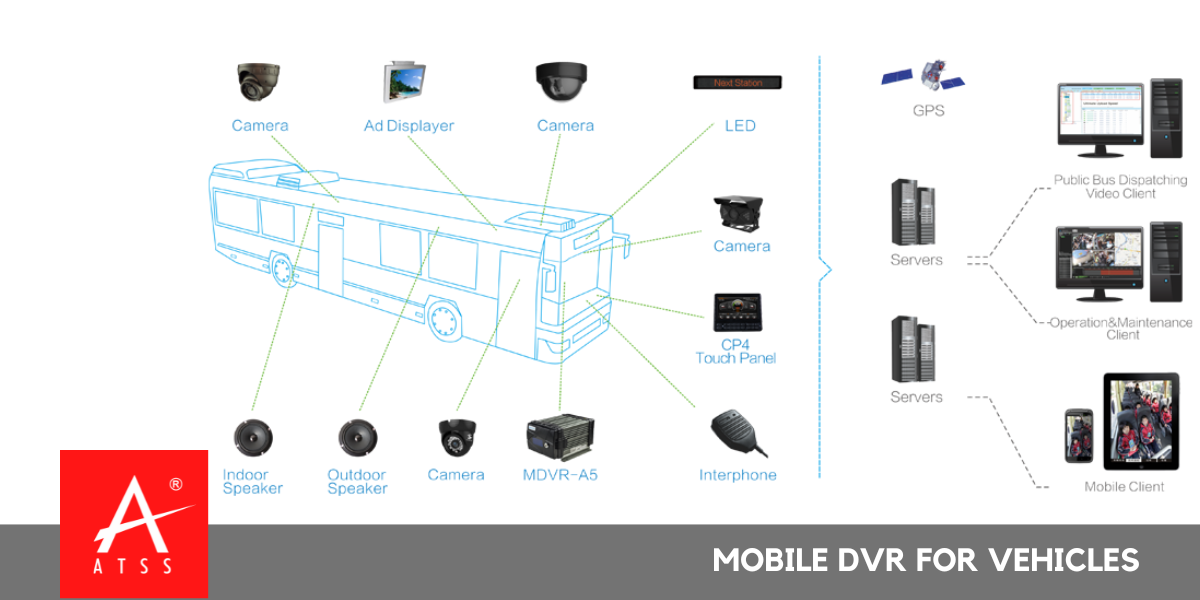
Mobile Dvr For Vehicles
Mobile Dvr For Bus | CCTV Surveillance For School Buses
Mobile Dvr For Vehicles We often heard a lot of people asking: What is Mobile DVR? What’s the difference between Mobile DVR (Vehicle DVR) and regular car DVR? What benefits could Mobile DVR bring to us? Ok, Today, We’ll explain it to you step by step clearly.
As we all know, transportation is part of nearly everybody’s daily life; people use vehicles for work and leisure travel, schools dispatch buses to pick up students and send them home, and logistics companies use vehicles to deliver goods. We can say the very fabric of society – people and assets – is being transported from one place to another every minute of every day. So securing them is obviously extremely important. A mobile DVR has one of its prime roles in helping to secure such situations, protecting people flow and assets, and ensuring the safety of traffic environments.
Many customers confuse mobile DVRs with regular DVRs, Though the functionality of a general-purpose car DVR and a mobile DVR may be similar, it is not a case of “one type fits all.” I mean it is totally different in some aspects. The comparison is more like adapting a novel into a movie, where different uses create different possibilities. A mobile DVR is specifically designed for vehicles, such as buses, armored cars, subway trains, etc. A good quality mobile DVR can record for a continuous time without failure; it can withstand the frequent vibration and unstable power supply associated with vehicles, factors which are fatal to a regular DVR. It can provide evidence of traffic accidents and terrorist attacks while uploading alarm information to a control center in emergency situations through 3G / 4G functions. A good quality mobile DVR will also have a long life span and give a stable performance, which helps customers to reduce maintenance costs.
The main difference between a regular DVR and a mobile DVR lies in the environments in which they are meant to be used. Here we give five factors that define an appropriate mobile solution: Power Supply, Anti-vibration Mechanism, Dust Prevention, Heat Dissipation, Solid Interface, and Data Transmission.
1) Power Supply
As a mobile DVR mostly be located on the vehicle, its power supply must be drawn from the vehicle as well. In vehicles, the voltage is currently 12V, 24V, and 110V, and is not as stable as that of indoor locations, especially during engine start-up and braking when voltage can fall to 9V or less. This creates a very unstable power supply. So the mobile DVR must need to support wide voltage input.
Electronics are very sensitive to power surges and spikes, and equipment fails quickly if they are not handled properly. Additionally, the mobile DVR acts as a hub that stabilizes power for sensors and cameras. However, some manufacturers use low-quality power supplies to reduce costs, but this inevitably shortens the life span of their products. So, identifying a mobile DVR with an excellent power supply is crucial. Here we list some international standards relating to power systems for your reference: ISO 7637-2: 2004, JASO D001-94, SAE-1455. Customers can refer to these standards when buying mobile DVRs.
2) Anti-vibration Mechanism
Since vehicles are constantly in motion, vibration is inevitable. Constant vibration leads to mechanical failure if it is not considered during design. One of the factors that set rival products apart is the materials used for anti-vibration / shock-proof mechanisms. Most manufacturers use rubber to contain vibration since the use of rubber lowers production costs. However, it deteriorates over time. Generally, rubber guarantees performance in short time frames but is susceptible to heat and cold, which softens or hardens the rubber. Higher-end mobile DVRs use wire rope, which ensures performance regardless of external factors.
3) Dust Prevention and Heat Dissipation
Mobile DVRs are generally installed in confined spaces and compartments. This exacerbates the problem of heat dissipation because mobile DVRs are required to operate for a long time in such a confined environment. The challenge here is twofold. If you try to fit fans into the DVR, you will inevitably leave an opening in the enclosure and make it more vulnerable to dust. For this reason, fans are not accepting mobile DVRs, and an alternative approach must be considered. Besides, aluminum is the preferred material for enclosures as it allows heat to dissipate even when it is completely sealed in. Low-cost mobile DVRs may use aluminum alloys instead of pure aluminum to reduce costs, but they will prove incapable of handling dust and heat adequately.
4) Solid Interface
Due to the constant vibration on and within vehicles, a solid interface that combines devices is crucial to ensure a continuous and stable running environment. A BNC interface is standard for regular DVRs but it is not suitable for mobile DVRs since the BNC interface can easily loosen due to frequent bumps. A high-end mobile DVR adopts a solid aviation specification interface, it can sustain vibration, ensuring the continuous transmission of power, signals, and other data without failure. However, some manufacturers use a common aviation specification interface that is not eco-friendly and is not sufficiently solid; such interfaces can easily break down over time.
5) Data transmission
In the past, the transmission was the weakest link for many mobile DVRs, but this has changed due to advances in wireless technologies. Previously, innovation in mobile DVRs was slow as the limited transmission options constrained how manufacturers could add value for users. Even Wi-Fi was not as significant as some thought it would be due to its Bandwidth fluctuation.
The availability of 3G, even now 4G networks has enabled a wide variety of new functions. For example, it was not previously practical to transmit data collected from the vehicle in real-time, such as video, location, brake signals, speed, and inertial measurements. However, all of this can be achieved in a mobile DVR for vehicles. What’s more, it could also support the intercom functions too.
The above advantages and features have seen mobile DVRs being widely used in the sector; Mobile DVRs are surely the best choice for mobile surveillance due to their professional design for use in vehicles. In view of traffic accidents, legal mandates have been formulated to strengthen surveillance protection. For this reason, the potential mobile surveillance market may become very large. Customers should be aware of the features of mobile DVRs and select appropriate solutions in different applications accordingly.

